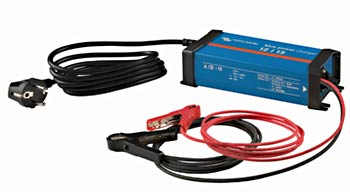January 18, 2016
I see boats sitting at the dock with the engine running for hours at a time, making noise, making diesel exhaust fumes for their neighbors and using up expensive engine lifetime, all for no reason. Oh, they’d say it’s to charge batteries. They’re always US or Canadian boats. They have 120 volt systems, while the rest of the world uses 220 to 240 volts.
They’ve often been told that they’d need to spend thousands to rewire their boat. They’d need to comply with a multitude of regulations and get a Warrant of Fitness (NZ) every year at a cost of hundreds of dollars. Wrong-o-buck-o! There’s a better way.
Maybe we stumbled into this blindly, or maybe we’re just cheap, or maybe just lucky, but what we did for under $200 has been working so well for us.
When we first got to Opua, New Zealand four years ago, we bought and “installed” a very inexpensive, 10 amp charger (ours happens to be made by Victron Energy but there are many to choose from). We cut off the alligator clips and wired the output side into our 12 volt system. I put “installed” in quotes because we left the NZ AC plug intact.
We plug the charger into an inspected (WOF’ed) power cord and leave it on all the time (or at least we did, before we had more solar power than we know what to do with!). Each year in NZ, we need to get our cord inspected, but that’s $25 or so – much less than getting the all the boat’s wiring inspected.
I’ve called this a trickle charger, only because of the low, 10 amp charging rate, but it’s not a typical trickle charger. It’s actually a sophisticated, 4 stage charger that won’t harm batteries if left on indefinitely. Ten amps isn’t much, but multiply it by 24 hours and we’re talking 240 amp-hours. That’s more than we can use, especially when supplemented by even moderate solar or wind power.
For AC, at least the US and Canadian 110 volt flavor, we use our inverter. We plug our little 230 volt space heater into a Y connector, plugged into the power cord. That’s also how we connect or New Zealand purchased power tools.
Done. That’s it. No rewiring. No excessive engine or generator hours. No annoyed neighbors. No hassle. -Rich






